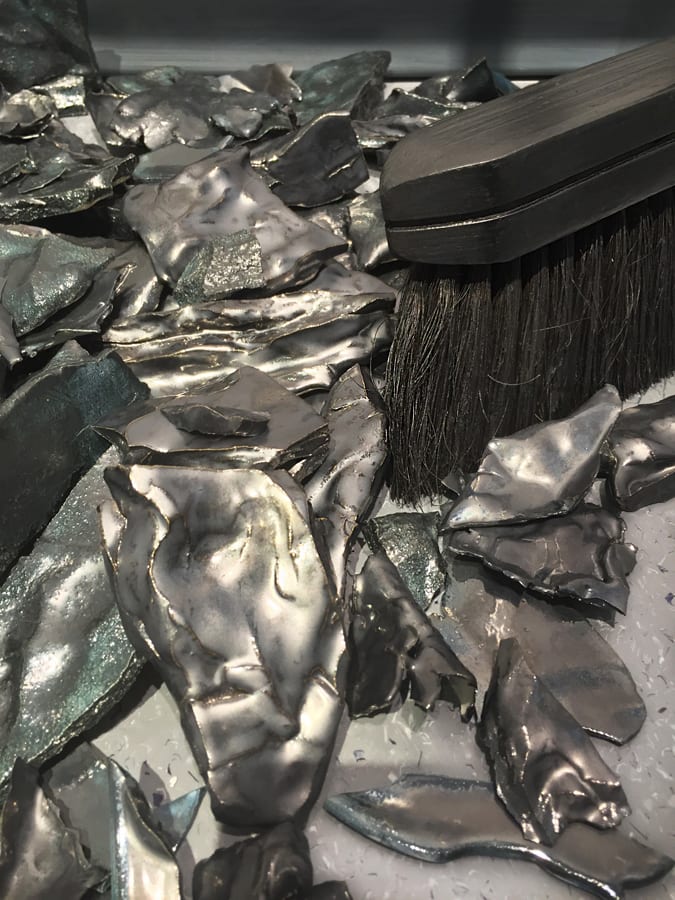
In 2011, I was standing in Diana Shpungin’s studio as she talked about a new series of intense, graphite-covered objects created in reference to her father and his passing that were to be included in her upcoming solo exhibition at Stephan Stoyanov Gallery. Though she once worked as part of a collaborative team, by then Shpungin’s practice had changed to a solo one as she began to work intensely on objects and animation. In a review of Shpungin’s show, (Untitled) Portrait of Dad, for Whitehot Magazine, Megan Garwood wrote:
“We presume that mortality lies still in accords with our social and theoretical expectations that reassure our human psyche—a mind that requires closure with goodbyes. Conversely, Diana Shpungin renders counterintuitive living apparitions of her late father in Shpungin’s first brazen solo exhibition (Untitled) Portrait of Dad. Comprised mainly of haunting black pencil on paper, the show’s works unfurl memories of ubiquitous paternal images. As content dissolves into form, Shpungin’s gritty surfaces allude to repetitive meditation and expose Shpungin’s individualistic style, as this is her first show after nearly ten years of collaboration with another artist. Drawings appear unfinished. However the artist loops her drawing series into rough animations. Surprisingly, the rhythmic viewing stables her appropriately disturbing images. They no longer stir.”1
This first paragraph of Garwood’s review speaks to everything that the amazing works deal with, particularly the intensely developed process of drawing with graphite pencil on objects until they are cloaked in a silvery sheen. However, it misses the one thought that I couldn’t shake. To make these works, one has to spend an incredible amount of time alone in a pristine studio. What does that do to you as an artist and a person? How can these objects move beyond the privacy of the four walls and into a more critical realm of the gallery and commodification? Thus began our conversation about studio practices, method, and meeting new people.
—Caitlin Masley-Charlet
This was included in the installation of Drawing of a House (Triptych) (2015).
Caitlin Masley-Charlet: I want to talk about the trajectory of your practice. There have been many conversations in recent years surrounding how artists are graduating from MFA programs not only with debt, but also unable to afford space for living and working, not to mention how difficult it can be to find time for experimentation and even risking failure in a studio practice. Can you share a bit about graduate school? What were you going through as it came to an end, and what the next steps were?
Diana Shpungin: I was working in a collaboration after graduating with my MFA from the School of Visual Arts in New York in 2002. This helped tremendously by sharing costs and labor. We primarily made video work, so our costs for studio space and storage were relatively low. We were fortunate enough to have some immediate success right out of the gate, and our youth provided the energy needed to sustain our drive. Student debt was a serious issue then, and it’s even more so now. I took out some loans, though they were nothing like the ones students are facing now. Certainly the costs have been accelerated in the last five years, and, moving forward, things are not looking promising in terms of affordability. It’s unfortunate that education is becoming a luxury good. The whole system needs a severe overhaul. In terms of art making, there is always a risk for failure if you are doing it correctly. In a big way, that is the fun part. Failing and learning from it is where success comes from.
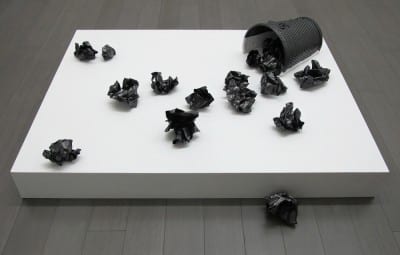
Masley-Charlet: After school, how were you sustaining your practice? How would you personally define sustaining financially or creatively?
Shpungin: It depends on what you mean by sustaining. Sustaining the drive and determination to make art is purely a self-propelling force that I can’t quite explain.
Masley-Charlet: If you can’t explain this force, could you speak about it in terms of what kind of parameters that support, encourage, or inspire it? Is it something tangible, such as having a community of artists to dialogue with regularly, or having access to see art often?
Shpungin: I believe that sustaining myself as an artist is a personal fixation. To sustain is to keep thinking, making, participating—because what else would I do? Making art, as truly integral and important as it is to civilization, is not overtly valued by society and its inherent power structures. I sustain because visual culture is so important to me; it’s a way in which to comprehend the world, and I have no other choice, at least none that wouldn’t make me miserable. This is what feels authentic: to create this body of work. Without sounding too metaphysical or trite, I feel like art is an otherworldly entity. I simultaneously have both total control and little control over what I make. The artworks know what they want, and perhaps I am just a catalyst to get them there and to listen to them. In the studio, I ultimately have to please the artworks and then myself. Beyond that, if there is outside acknowledgment, dialogue, and idea exchange, that can be rewarding and certainly can facilitate the drive to persevere.
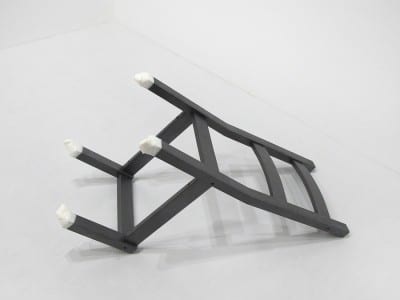
My collaborative partnership lasted for almost eight years past graduate school. After that ended, I had to retool my artistic practice into a single agent. It was a difficult and exciting time. I reinvented my approach to the art-making process, creating a new body of work that is now ongoing. This new work was introduced in 2011 with my first solo show. It was well-received with reviews in Artforum, New York Magazine, Art in America, and others, and it developed a small collector base for my work. Additionally, it opened the door to artist grants, residencies, and other opportunities that arose later for large, funded artist projects. Sustainability can be nurtured from one project to the next. You do one great project, someone sees it (Foundation For Contemporary Art, Artist Emergency Project Grant, Frey Foundation, Artist Seed Grant, Grand Rapids, MI, MacDowell Colony Residency Fellowship,VLA Art & Law Residency Program, NY, Lower Manhattan Cultural Council, Swing Space Residency Award, NY, AIM Program, Artists in The Marketplace, Bronx Museum of Art, NY) and likes it, and another opportunity forms. Artists must be persistent in their passion and pursuit of their work. They must constantly be willing to reevaluate both the work and how to support its studio production—it’s always changing.
Masley-Charlet: What about the financial aspect of making your work? Does what you have access to materially and financially set a trajectory of what gets made? Does this include access to space and other opportunities?
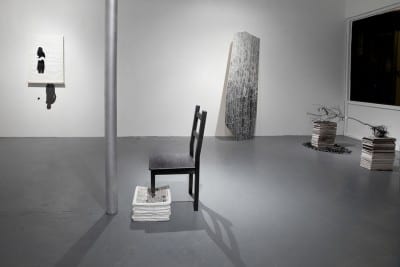
Shpungin: What resources you are given can greatly affect the work. Sometimes you have an idea and seek out a situation that can foster it. Other times, you can allow a situation to pleasantly surprise you. I don’t think I or most artists can have too much space, resources, funding, or opportunities. It’s always helpful, and as artists we are hopeful that organizations will come through with funding to complete a project from start to finish, but that is not always possible. When showing in a commercial setting, sales help and occasionally a collector might commission a work. I teach at the university level, and that helps with a bit of income. Teaching also sustains me in other ways, through mentoring and continuing a dialogue with a younger generation of artists.
Masley-Charlet: You often create intense projects, most recently Drawing of a House (Triptych) (2015) in Grand Rapids, Michigan. How was this project possible?
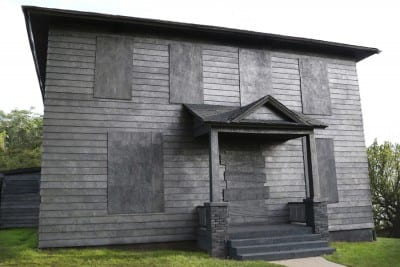
Shpungin: Drawing of a House (Triptych), which I recently I completed, was a large public project that I created with SiTE:LAB. It involved covering an entire two-story abandoned home and former rectory by hand with graphite pencil. There were nine hand-drawn animations projected through the windows of the home. The project was an enormous undertaking and was funded by the organizations SiTE:LAB, Habitat for Humanity, and other outside granting sources, including the Frey Foundation and the Foundation for Contemporary Arts. SiTE:LAB also provided invaluable labor and organized a tremendous amount of enthusiastic volunteers from the community, which was integral to the project both practically and conceptually.
Masley-Charlet: When did you first start applying to artist residencies, and what are your thoughts on residencies?
Shpungin: In 2011, I applied to CarriageHouse Arts in Islip, Long Island, at the suggestion of a curator friend. I thought it was a nice way to stay in town while still getting away. They provided generous funding and a large studio space. It was also appealing because of its proximity to the ocean where I filmed much source footage for multiple hand-drawn animations. I decided it was time to get out of my solitary studio environment for a change of scenery, a shift in thinking, an opportunity for discourse, and the general community aspect a residency can nurture.

Masley-Charlet: Many artists today work in or with communities and share resources or spaces. What was the pull to have the solitary studio environment and how did this relate to you post-graduation?
Shpungin: During and after my time in graduate school, I worked in a collaboration for almost a decade, so I always had company and constant dialogue in the studio. At the time residencies were more limited for collaborative groups. When I branched out and started to make my individual body of work, I found that the constant, solitary studio environment was a shock to my system. When I told my artist friends how I felt, they all said: “This is how we all feel—welcome to the club.” And eureka! It then occurred to me to apply to residencies.
Besides having people over for regular studio visits, the idea of a residency can not only get you out of your own physical space but also your mental space too. The residency experience varies greatly depending on many factors, and different programs provide distinctive benefits. Some are based on making work or experimentation, and others on community, resources, and dialogue. There are varied facilities, locations, funding, housing, travel, amenities, and food. When I went to the MacDowell Colony, it was very productive in terms of making art and in influences on my work. It generously gave me a huge, private studio space in the woods and three fantastic meals a day. I would not have predicted that the simplicity of not having to think about what to eat would be so helpful. It allowed for solid, uninterrupted time to think and make work. I was in the studio for at least eight hours every day of my residency. The isolated, woodsy location influenced my work’s subjects—and its content. By contrast, Guttenberg Arts was great for a number of different reasons: the funding, the friendly and accommodating staff, and, most important, the ceramic and printmaking facilities that gave me the ability to experiment in the new medium of ceramics. Working in ceramics was eye opening; I gained such an appreciation for the process and was able to link this medium to my way of thinking and making.
The wild card aspect to any residency program is one thing they all have in common: you do not know what will come of it. You can always get some work done, but how each experience influences that work is what’s fascinating. You also don’t know the people you might meet. It’s interesting when a group of creatives are thrown together in a residency situation, and the possibilities of what that means both for the artwork’s direction and for making meaningful and supportive connections.
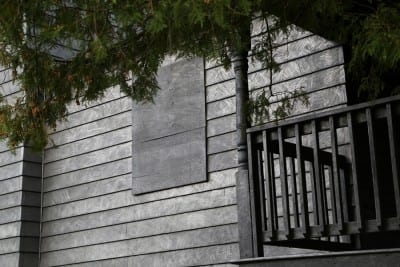
Masley-Charlet: What is the importance of an artistic community for you, and has it changed over the years? I’ve seen a rise in the last decade of critique groups that have formed after graduate school. Have you ever been asked to join one, or found yourself at a monthly dinner of friends who are artists?
Shpungin: It is important to get out of your own head now and again, by seeing what others are working on, exchanging ideas, solving problems, learning new methods, and friendship and camaraderie in general. These relationships often last for years past the residency experience. Living in New York, it’s tricky to have lengthy amounts of time to spend with people. When I travel or am in a residency, everyone slows down slightly. That is when real exchange and communal bonds can happen.
As I progress in my career, I see growing value in the idea of community and maintaining relationships with like-minded people who have crossed my path. I think if something works for someone then it can’t be bad, whatever framework they choose—an artist critique group or something less structured. It can certainly be isolating for many after leaving the bubble of graduate school. I have generally maintained a close-knit group of artist friends I trust and invite over when works are in progress, and I do the same for them. It’s lovely, but not so structured—more like a bottle of wine and some good, honest conversation.
Masley-Charlet: This slowing down that you mentioned—why is that necessary to create a real exchange or a communal bond?

Shpungin: Many of my now closest friendships in New York were formed elsewhere. In New York, we are all busy and pressured—too much to see, too much to do, too much guilt for not attending this or that. When you meet people elsewhere, there is nothing to do sometimes but kill time. Killing time is never an option when you live in New York. I would like to have leisurely days, but they are rare. Even having grown up here, and as much as I love this city, it has a kind of subliminal psychological hold on many.
Masley-Charlet: What interested you about the Guttenberg Arts residency?
Shpungin: The facilities. I had never worked in ceramics before and the idea of experimenting in that medium appealed to me. I thought it could translate nicely to the materials, concepts, and themes I already work with while bridging a new direction. I had both a lot of failures and successes, and managed to produce a good amount of work, specifically ceramics works that translated into drawings, and vice versa. It was the first time materiality played such a strong role in the outcome of my work. The porcelain dictated the result of the work, and that was new for me.
Guttenberg Arts also provided the staff to guide me in my experimentation in developing new work. The facilities are well-maintained with great equipment in each area. Moreover, the artist community provided other voices in the evaluation of the new work’s production. Guttenberg Arts has the vision to provide a studio stipend to the artists which dramatically assisted me by funding materials costs for the work.
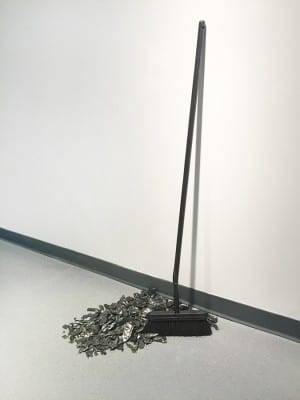
Masley-Charlet: Can you speak a bit about what has changed in your process since you’ve been in residence at Guttenberg Arts?
Shpungin: I rarely take time to experiment. Normally my process is that of thinking, writing, list making, sketching, sourcing, shopping, and making the work once the idea and all parts are finalized. At this residency, I was able to have a lot of experimentation and trial and error with the materials to find new modes of thinking and making. The materials dictated the work’s ideas, not the other way around. It’s been good to get out of the same way of working, if even for a short period of time.
The idea that there is no pressure to produce a shiny, new body of work at Guttenberg Arts certainly supports experimentation. Most artists want to produce work anyway, but the idea that Guttenberg Arts affords you time to play is enriching. In terms of support for experimentation, the possibilities of collaborations between staff and residents could be an interesting test—as well as possible failure. Failure is important to me in my work, both practically and conceptually. At Guttenberg Arts and working in ceramics, there was so much wait time and trial and error—a lot of real failure, but also failures that led to answers of what was feasible. I made works that were laborious, but appeared like they could either be made easily or as possible failures—intentionally of course. I say everyone should fail often and fail big.
This was included in the installation of Drawing of a House (Triptych) (2015).
Masley-Charlet: Often when artists go to residencies they feel pressure to make a whole new body of work.
Shpungin: I wanted to explore the parameters of ceramics and learn a lot. While I didn’t feel the need to produce a body of work, I ended up doing so. It wasn’t until it was packed up that I realized how much I actually made. The knowledge gained at Guttenberg Arts will definitely influence future projects.
Masley-Charlet: How do you think about the studio visits that Guttenberg Arts has set up? Do you think that residencies should make more connections to museums and galleries or curators and historians?
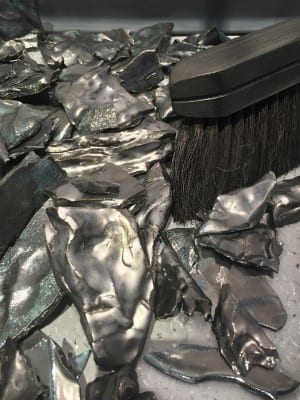
Shpungin: Studio visits are always essential. Any opportunity to engage with others about your work has the prospect of being useful. A radically different point of view or spirited disagreement still presents you with a chance to gain insight. The studio visits Guttenberg Arts set up were an opportunity to share my work and receive input and knowledge from varied perspectives, as well as make professional connections. Normally, my projects are nearly complete before I show them to others. I think it was especially interesting for me to discuss work that was both in a medium so new to me and in process. This took me out of my regular approach, and even if I revert back, it’s still a valuable experiment.
Masley-Charlet: How comfortable are you giving artists talks? At Guttenberg Arts, we ask the artist to give one during the exhibition opening, which is how we’ve seen it done in residencies in Europe. It helps the audience understand what they are experiencing.
Shpungin: I enjoy going to and giving artist talks. Listening to others can really give great insight into their work. It can make you respond more or less positively. When I lecture on my own work, it is generally to impart the back story, how this work got made, and how the ideas materialized.
Masley-Charlet: Was having another exhibition something that was helpful or too much pressure during your residency?
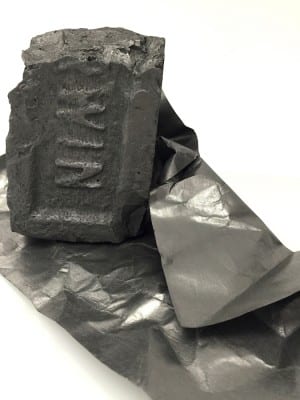
Shpungin: Exhibiting work is always a good thing, provided the work is shown in the manner intended. Guttenberg Arts allowed me to have full control of how my work was presented, and the trust and enthusiasm of the staff was remarkable.
Masley-Charlet: There are three residents at Guttenberg Arts while you were there, with three different work schedules. Were you able to connect with the other residents?
Shpungin: It was fantastic spending time with all my fellow residents and the staff. For one example, I was acquainted with my fellow resident Roberto Visani before Guttenberg Arts, but the residency allowed us time for conversations where we attempted to (unsuccessfully) solve all of the world’s problems. Actually, Roberto and I just took a road trip together to be visiting artists at Indiana University Bloomington’s sculpture department. More intense conversations were had and a lovely friendship solidified.
Diana Shpungin is a multidisciplinary artist based in Brooklyn, who works in drawing, sculpture, installation, hand-drawn animation, video, and sound. She has exhibited extensively in solo and group exhibitions in both national and international venues, including the Bronx Museum of the Arts, New York; SculptureCenter, Long Island City, New York; Bass Museum of Art, Miami; Fieldgate Gallery, London; Futura Center for Contemporary Art, Prague; Tomio Koyama Gallery, Tokyo; Carrousel du Louvre, Paris; Invisible-Exports, New York; Stephan Stoyanov Gallery, New York; Marc Straus Gallery, New York; Museum of Contemporary Art, Miami; Brooklyn Museum of Art, New York; Palm Beach Institute for Contemporary Art, Florida; Marella Arte Contemporanea, Milan; Galerie Zürcher, Paris; SiTE:LAB, Grand Rapids, Michigan; and the Geisai art fair, organized by Takashi Murakami for Art Basel Miami.
Shpungin’s work has been reviewed in publications such as Artforum, Flash Art, New York Magazine, Art in America, Art Papers, Sculpture Magazine, Village Voice, New York Times, NY Arts Magazine, Timeout New York, Zing Magazine, Bloomberg, M/The New York Art World, Timeout London, Connaissance des Arts, Le Monde, Whitehot Magazine, Boston Globe, and Miami Herald, among others. Her work was the subject of a recent episode of PBS’s Art Assignment, “Object Empathy,” and was cited in the introduction of Jerry Saltz’s most recent book, Seeing Out Louder: Art Criticism, 2003–2009. Shpungin has been awarded residencies with MacDowell Colony, Lower Manhattan Cultural Council, VLA Art & Law Residency Program, Bronx Museum Artists in the Marketplace (AIM) Program, Guttenberg Arts, and CarriageHouse Arts.
Caitlin Masley-Charlet is a Brooklyn-based visual artist working in drawing, installation, and sculpture, and the deputy director of Guttenberg Arts in Guttenberg, New Jersey. She holds a MFA from the University of Arizona and a MS in design and urban ecology from Parsons/The New School. She is the recipient of several grants and fellowships, including an Emerging Artist Fellowship from the Socrates Sculpture Park, Pollock-Krasner Fellowship, Barbara Deming Memorial Fund Grant, Puffin Foundation Grant, Foundation for Contemporary Arts Emergency Grant, and the Lower Manhattan Cultural Council Swing Space Grant and Residency, among others.
Masley-Charlet has been artist-in-residence in Austria, Germany, Quebec, Norway, and Switzerland. Her work has been exhibited in group shows at MoMA/PS1, Long Island City, New York; Center for Built Environment, Berkeley, California; and Storefront for Art and Architecture, New York. She has had site-specific solo exhibitions at McColl Center for Contemporary Art, Charlotte, North Carolina; Islip Museum, East Islip, New York; Urban Institute of Contemporary Art, Grand Rapids, Michigan; HVcc Foundation, Troy, New York; Kingston Museum of Contemporary Art, Kingston, New York; and the HDLU Museum, Zagreb, Croatia. Masley-Charlet will create a new large-scale installation at the Katonah Museum of Art, Katonah, New York. She is also the founder of studioMAPstudioSWAP, which is part of the Parsons/DESIS Lab/CSI Incubator program.
- Megan Garwood, “Diana Shpungin: (Untitled) Portrait of Dad,” Whitehot Magazine at http://whitehotmagazine.com/articles/diana-shpungin-untitled-portrait-dad/2317, as of June 10, 2016. ↩

